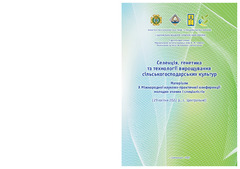Приказ основних података о документу
Nutritive quality and plant digestibility of silage maize hybrids from Serbia
| dc.creator | Nikolić, Valentina | |
| dc.creator | Simić, Marijana | |
| dc.creator | Žilić, Slađana | |
| dc.date.accessioned | 2022-05-16T07:35:11Z | |
| dc.date.available | 2022-05-16T07:35:11Z | |
| dc.date.issued | 2022 | |
| dc.identifier.uri | http://rik.mrizp.rs/handle/123456789/898 | |
| dc.description.abstract | The quality of five silage maize hybrids grown in 2020 at five different locations in Serbia (two in the northern province of Vojvodina (Srem) and three in Central Serbia) was tested in 2021 in the laboratory of the Department of Food Technology and Biochemistry of the Maize Research Institute “Zemun Polje“. The dry matter content, lignocellulose fiber content, and in vitro dry matter digestibility (IVDMD) of of the whole plant maize hybrids: ZP 707, ZP 7357, ZP 790, ZP 8701, and ZP 873 were investigated. The 7001 hybrid was used as a standard. The average dry matter content varied between 37.77±1.88% (ZP 790) and 42.64±7.19% (ZP 707), while in vitro dry matter digestibility ranged from 58.77±1.96% (ZP 8701) to 63.77±2.09% (ZP 707). The share, as well as the type of the plant cell wall components – lignocellulosic fibers, determines the nutritional quality of silage maize as animal feed. The NDF content ranged from As the NDF content increases with maize maturity, animals show a tendency for lower silage intake. However, although in some cases NDF can be considered a negative indicator of silage quality, NDF is a necessary component of ruminant nutrition. Based on the achieved results, it can be concluded that hybrids ZP 707 and ZP 7357 proved to be the best silage maize forms. At most locations, these hybrids achieved better results than the standard. The ZP 707 hybrid on average had the highest dry matter content, the highest digestibility of dry matter, as well as the lowest content of all lignocellulosic fibers, which all indicate its potential as silage maize form. The lack of hybrids ZP 707 and ZP 7357 can be considered the fact that the dry matter content of the whole plant showed to be less stable in different agro-ecological conditions.In terms of digestibility and dry matter content, the ZP 790 hybrid can be singled out as the most stable. The ZP 790 hybrid is less recommended for Srem, but in Central Serbia, it could match the ZP 707 and ZP 7357 hybrids. ZP 8701 proved to be the weakest hybrid at all locations, followed by ZP 873. The in vitro digestibility and dry matter content of the whole plant of the investigated hybrids were far more stable in Srem than in Central Serbia. These findings can be of great importance for future breeding programs directed toward creating new and improved silage maize hybrids. | sr |
| dc.language.iso | en | sr |
| dc.publisher | Kiev : Ukrainian Institute for Plant Variety Examination | sr |
| dc.relation | info:eu-repo/grantAgreement/MESTD/inst-2020/200040/RS// | sr |
| dc.rights | openAccess | sr |
| dc.rights.uri | https://creativecommons.org/licenses/by/4.0/ | |
| dc.source | 10. International applied science conference of young scientists and experts, April 29, 2022, the village of Tsentralne, Kyiv region, Ukraine - Book of proceedings | sr |
| dc.subject | maize | sr |
| dc.subject | silage | sr |
| dc.subject | nutritive quality | sr |
| dc.title | Nutritive quality and plant digestibility of silage maize hybrids from Serbia | sr |
| dc.type | conferenceObject | sr |
| dc.rights.license | BY | sr |
| dc.citation.spage | 78 | |
| dc.citation.epage | 79 | |
| dc.identifier.fulltext | http://rik.mrizp.rs/bitstream/id/4502/bitstream_4502.pdf | |
| dc.identifier.rcub | https://hdl.handle.net/21.15107/rcub_rik_898 | |
| dc.type.version | publishedVersion | sr |


